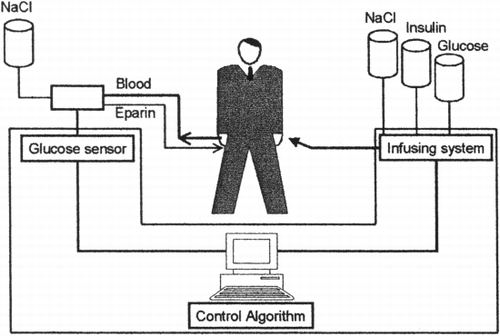Figures & data
Figure 1. Overall architecture of an endocrine artificial pancreas. The artificial endocrine pancreas consists of a system for continuous glucose sampling, an electrode for continuous glucose monitoring, a software for the management of the collected data and a system of pumps for continuous feed‐‐back insulin infusion and glucose supply in case of hypoglycaemia.

Figure 2. Transcutaneous needle‐‐type glucose sensor. The sensor is based on the glucose oxidase immobilization on the tip of a tube that consists of a platinum wire ((the anode)) and of a steel tube stained with silver ((the catode)) The glucose oxidase in the presence of glucose, oxygen and of a 0–6 V volt current catalyses a reaction that generates gluconic acid and hydrogen peroxide; the sensor measures the generated hydrogen peroxide. ((Adapted from Shichiri et al. (([Citation1988])).))
![Figure 2. Transcutaneous needle‐‐type glucose sensor. The sensor is based on the glucose oxidase immobilization on the tip of a tube that consists of a platinum wire ((the anode)) and of a steel tube stained with silver ((the catode)) The glucose oxidase in the presence of glucose, oxygen and of a 0–6 V volt current catalyses a reaction that generates gluconic acid and hydrogen peroxide; the sensor measures the generated hydrogen peroxide. ((Adapted from Shichiri et al. (([Citation1988])).))](/cms/asset/4cd27b1d-1e89-413a-8cc4-228bf2c20b79/ianb19_a_11116852_uf0002_b.gif)
Figure 3. Minimally invasive sampling techniques. Three different minimally invasive sampling techniques for continuous glucose sampling that are based on the extraction of glucose from the interstitial fluid for an external determination. A)) Microdyalisis, B)) Open flow microperfusion and C)) reverse iontophoresis. ((Adapted from Hashigughi et al. (([Citation1994])), Trajanoski et al. (([Citation1997])), and Pickup (([Citation2000])).))
![Figure 3. Minimally invasive sampling techniques. Three different minimally invasive sampling techniques for continuous glucose sampling that are based on the extraction of glucose from the interstitial fluid for an external determination. A)) Microdyalisis, B)) Open flow microperfusion and C)) reverse iontophoresis. ((Adapted from Hashigughi et al. (([Citation1994])), Trajanoski et al. (([Citation1997])), and Pickup (([Citation2000])).))](/cms/asset/4002dddd-63fa-484b-98ab-8f126914a232/ianb19_a_11116852_uf0003_b.gif)
Figure 4. Adicol overall architecture. The system consists of a glucose sensor for continuous glucose measurements, a physiological model of glucose metabolism in humans for the interpretation of the collected data and for the generation of the advice on insulin therapy and an infusing device for insulin administration.
